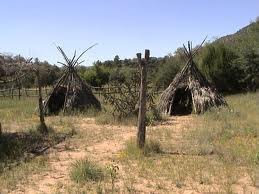Hoffmann states that at the 'medicine' lodges of some Algonquian tribes there are preserved fetishes or amulets worn above the elbows, consisting of strands of bead-work, metal bands, or skunk skins, while bracelets of shells, buckskin, or metal are also worn. A great tribal fetish of the Cheyenne was their 'medicine' arrow, which was taken from them by the Pawnees in battle. The head of this arrow projects from the bag which contains it, and it is covered with delicate waved or spiral lines, which denote its sacred character. It was, indeed, the palladium of the tribe. A peculiar type of fetish consisted of a mantle made from the skin of a deer and covered with feathers mixed with headings. It was made and used by the medicine-men as a mantle of invisibility, or charmed covering to enable spies to traverse an enemy's country in security. In this instance the fetishistic power depended upon the devices drawn upon the article. The principal fetishes among
the Hidatsa tribe of the Sioux are the skins of foxes and wolves, the favourite worn fetish being the stripe from the back of a wolf-skin with the tail hanging down the shoulders. A slit is made in the skin, through which the warrior puts his head, so that the skin of the wolf's head hangs down upon his breast. The most common tribal fetishes of the Sioux are, or were, buffalo heads, the neck-bones of which they preserve in the belief that the buffalo herds will thereby be prevented from removing to too great a distance. At certain periods they perform a ceremony with these bones, which consists in taking a potsherd filled with embers, throwing sweet-smelling grease upon it, and fumigating the bones with the smoke. There are certain trees and stones which are regarded as fetishes. To these offerings of red cloth, red paint, and other articles are made. Each individual has his personal fetish, and it is carried in all hunting and warlike excursions. It usually consists of a head, claws, stuffed skin, or other representative feature of the fetish animal. Even the horses are provided with fetishes, in the shape of a deer's horn, to ensure their swiftness. The rodent teeth of the beaver are regarded as potent charms, and are worn by little girls round their necks to make them industrious.
the Hidatsa tribe of the Sioux are the skins of foxes and wolves, the favourite worn fetish being the stripe from the back of a wolf-skin with the tail hanging down the shoulders. A slit is made in the skin, through which the warrior puts his head, so that the skin of the wolf's head hangs down upon his breast. The most common tribal fetishes of the Sioux are, or were, buffalo heads, the neck-bones of which they preserve in the belief that the buffalo herds will thereby be prevented from removing to too great a distance. At certain periods they perform a ceremony with these bones, which consists in taking a potsherd filled with embers, throwing sweet-smelling grease upon it, and fumigating the bones with the smoke. There are certain trees and stones which are regarded as fetishes. To these offerings of red cloth, red paint, and other articles are made. Each individual has his personal fetish, and it is carried in all hunting and warlike excursions. It usually consists of a head, claws, stuffed skin, or other representative feature of the fetish animal. Even the horses are provided with fetishes, in the shape of a deer's horn, to ensure their swiftness. The rodent teeth of the beaver are regarded as potent charms, and are worn by little girls round their necks to make them industrious.
At Sikyatki, in Arizona, a territorial nucleus of the Hopi Indians, Mr. Fewkes had opportunities of inspecting many interesting fetish forms. A number of these discovered in native graves were pebbles with a polished surface, or having a fancied resemblance to some animal shape. Many of the personal fetishes of the Hopi consist of fossils, some of which attain the rank of tribal fetishes and are wrapped up in sacred bundles, which are highly venerated. In one grave was found a single large fetish in the shape of a mountain }lion, made of sandstone, in which legs, ears, tail, and eyes are represented, the mouth still showing the red pigment with which it had been coloured. This is almost identical with some fetishes used by the Hopi at the present day.



























.jpg)

























